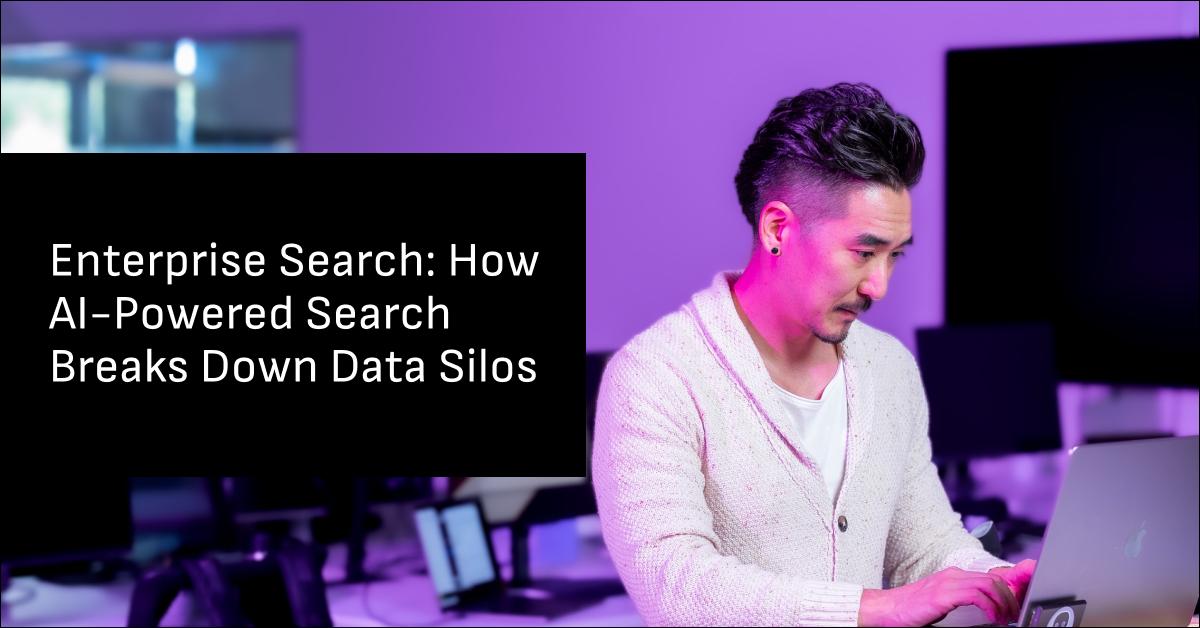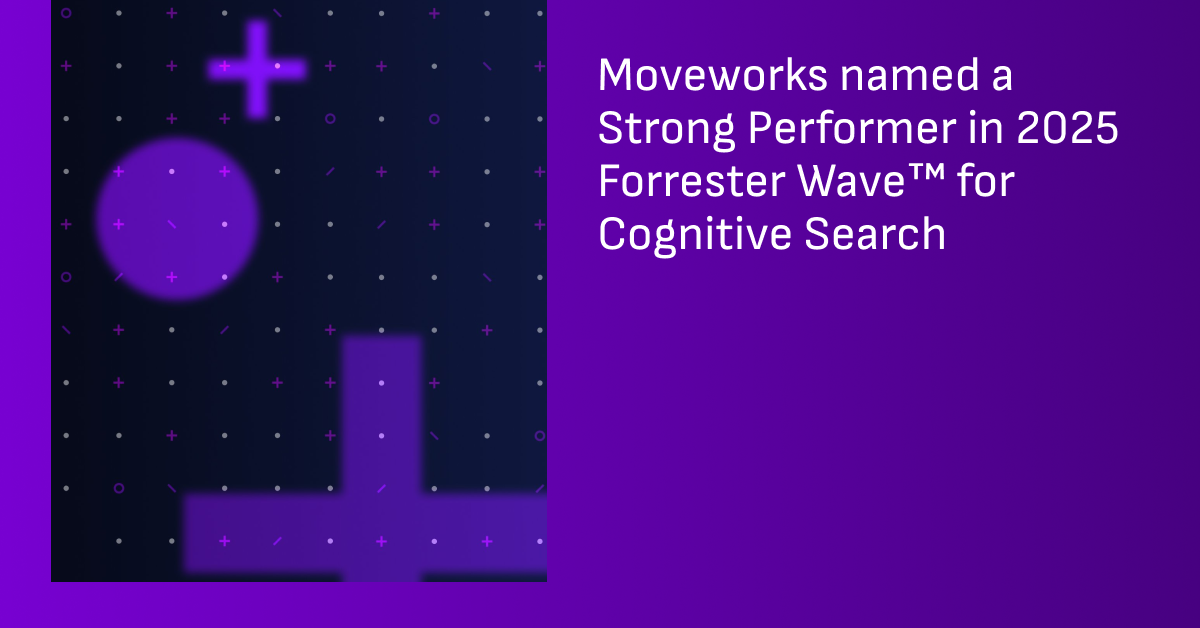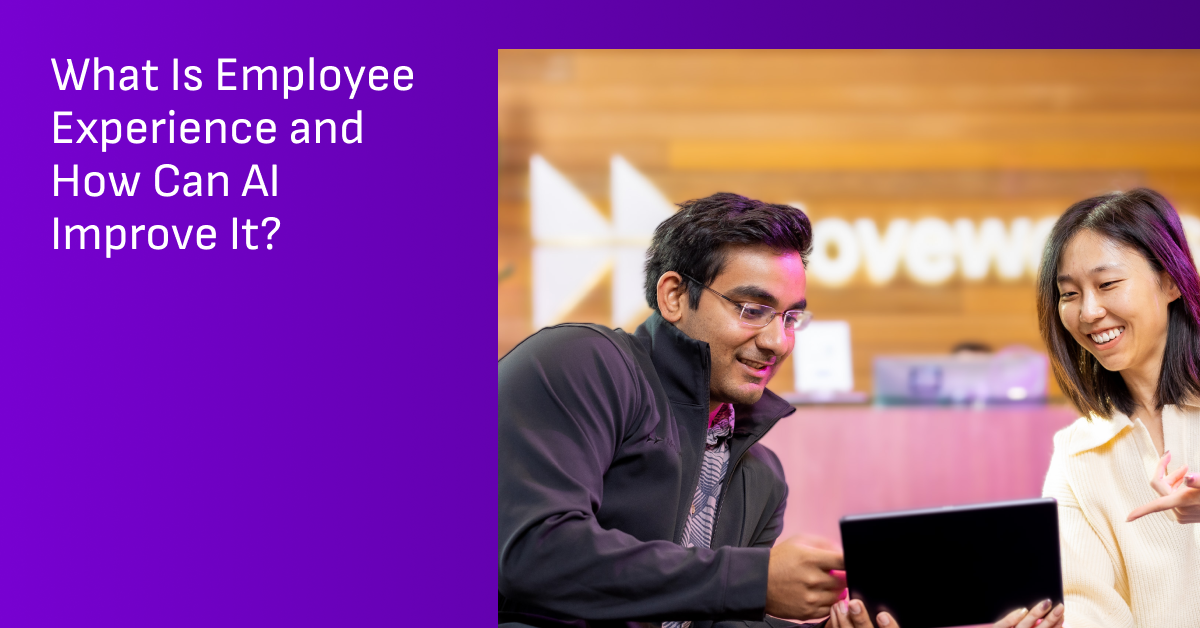Highlights
- Information silos hurt productivity: They arise from tool sprawl, fragmented knowledge bases, and strict security controls, making it harder for employees to find accurate, up-to-date information.
- Silos create hidden costs: Employees waste hours searching for data, duplicate work, and miss opportunities for collaboration and innovation, which undermines efficiency and the employee experience.
- AI-powered enterprise search breaks silos: By unifying data across disparate systems, it uses semantic search and generative AI to deliver contextual, accurate, and personalized answers.
- AI enhances search by improving the quality of retrieval and creating useful summaries. It uses advanced capabilities like natural language processing to understand the user's intent and context, not just keywords, for more personalized results and can generate concise, easy-to-read summaries of search results.
- The right solution balances power and usability: Enterprise search platforms should offer natural language understanding, comprehensive connectivity, scalability, granular security, and easy deployment to maximize adoption and value.
Your finance team swears by one expense policy. HR just rolled out another. Meanwhile, sales and marketing each track customer data in their own systems.
The result? Everyone’s working with a different “truth”—the classic symptom of an information silo.
Ultimately, these scenarios become barriers to the flow of information between different departments or teams within an organization. And these are just two examples. Information silos can arise from a variety of factors, including incompatible systems, lack of communication, or differing (or worse, conflicting) departmental priorities.
It might even be a combination of all of the above.
Information silos isolate knowledge within departments, tools, and systems, which can eventually lead to employee frustration and stalled productivity. In these instances, each team picks its own collaboration tools, creates separate knowledge bases, and builds workarounds that make finding reliable and relevant information feel like a treasure hunt.
But there's a better approach.
AI-powered enterprise search tools can change how teams access knowledge by connecting information from different, often departmentally specific, applications while maintaining strict security and compliance.
Instead of complex manual integrations, agentic AI can be used to search and unify knowledge across an entire tech stack, turning scattered data into a single source of truth for decision-making that helps employees find what they need, when they need it. Depending on the platform, it may go beyond search, taking actions on the user’s behalf (such as filing a PTO request, as opposed to merely looking up PTO policy).
Why do information silos happen?
Information silos aren't usually intentional. They typically develop organically as organizations grow and departments optimize and focus on their specific needs. Being aware of why and how they form can help you address the root causes, rather than feeling the continued effects of the symptoms.
Tech overload and tool sprawl
Your teams likely use dozens (or even hundreds!) of SaaS applications, as each department has its own unique requirements. Marketing needs design tools, sales wants CRM functionality, and engineering needs development platforms.
This tool sprawl creates disconnected data islands where information lives in isolation—so much so that anywhere from six to 15 hours of productivity may be lost every week. When every department picks its own tools, you might end up with customer data in Salesforce, project updates in Slack, policies in SharePoint, and training materials in your learning management system.
The problem is when information lives in different places, employees have to look in several places to stitch an answer together. This recall tax of knowing where to look and where the answer might be can end up turning into a huge productivity loss.
Fragmented knowledge sources
In many organizations, poor knowledge management creates a critical challenge: a lack of a clear, trusted source of truth. Employees, faced with this vacuum, tend to prioritize speed and convenience over credibility, often relying on unofficial, easily accessible information (like a coworker's shared document) rather than official, business-verified policies from departments like HR, IT, or Finance.
This tendency to use the most easily available information, regardless of its authority, can lead to misinformation, inconsistencies, or business risks, when the primary source of truth becomes lost in a sea of less-credible, but more easily found, alternatives.
Security and compliance barriers
Security policies can sometimes lock information in silos with access controls. However, when overly strict or sensitive these can prevent simple knowledge sharing. Different systems have different permission structures, making it hard to maintain security while enabling easy access to information.
This creates another hurdle: delivering secure, intelligent search thatrespect permissions while surfacing answers. This means you need solutions that understand who should see what information while providing effective search capabilities.
The impact of information silos
Information silos can create hidden costs that inflate over time, affecting everything from daily employee productivity to strategic initiatives.
Employees may waste valuable time searching for information instead of applying their expertise to strategic work. This may manifest as duplicating efforts when they can't find existing resources, recreating documents that already exist, and delaying projects while waiting for answers.
Silos can also undermine collaboration and innovation. When teams can't easily share knowledge, they miss opportunities to build on each other's work or learn from past successes and failures.
Perhaps most importantly, information silos hurt the employee experience. New hires struggle to get up to speed, experienced employees feel frustrated by inefficient processes, and everyone loses confidence in the systems they're all supposed to be relying on.
How AI enterprise search helps solve information silos
Enterprise search engines bring together all your systems and content—Slack/Teams/intranet, and more—using AI to simplify and accelerate information retrieval and understanding. They go beyond keyword matching, understanding user intent, context, and relationships between different pieces of information.
AI enhances search by improving the quality of retrieval and creating useful summaries.
AI-powered search platforms use semantic search capabilities to understand what employees are really asking for.
Perform a unified search to retrieve relevant answers rather than just links to files.
Apply generative AI to create contextual responses for specific queries.
The magic happens when search solutions layer in personalization, understanding business acronyms, employee roles, intent, and context to deliver increasingly relevant results.
Employees expect that ChatGPT-like experience now, or still get a traditional Google-like search experience. So having that flexibility to search as users prefer is crucial. AI and agentic RAG make this possible by understanding intent behind natural language questions, then pulling answers directly from the most relevant and up-to-date sources. They also adapt results dynamically based on context, role, and prior interactions, ensuring every employee gets both speed and accuracy without needing to know exactly where to look. Here’s how:
- Agentic AI: Automates smarter, contextual answers: Enterprise search pulls the right results and uses AI to uplevel it (for example, with summarized responses, it can understand your goals and intent). Agentic AI can completely change the way we find information. Agentic AI brings intelligence and autonomous decision making.
- Agentic RAG: Specifically for search, agentic retrieval-augmented generation (RAG) combines the strengths of AI agents with RAG to incorporate autonomous reasoning and decision making as part of finding relevant information. This approach allows for managing complex tasks across diverse and extensive datasets.
- Natural Language Understanding (NLU): Your search solution should understand context, relationships, and the user's intent. Instead of just matching keywords, look for platforms that use NLU to interpret conversational queries like, "What's our policy on remote work equipment?"
This is where agentic RAG becomes crucial. It allows the search agent to dynamically determine the best retrieval strategy and even refine its search based on user feedback or subsequent actions. This approach is a significant improvement over traditional RAG because the agent can proactively seek out additional context or clarification, leading to more precise and relevant answers.
- Comprehensive connectivity: A combination of indexing and live APIs ensures your search platform can access the full breadth of systems, knowledge bases, and content types across your organization.
The more content connectors available, the more comprehensive and effective your agentic search coverage becomes.
- Enterprise security & scalability: Your solution needs to handle millions of documents, support different file formats and types, and deliver fast results to thousands of users.
At the same time, it must manage security and permissions effectively, ensuring that AI agents only access information they are authorized to see, maintaining data integrity and compliance.
- High search quality: The ability to deliver precise answers—rather than just a list of keyword-matched documents—means employees spend less time searching and more time acting. Features like sentence-level embedding and semantic search help surface the most relevant information from across the organization. When users can quickly find what they need, adoption increases and frustration decreases
Break down silos and empower productivity with Moveworks
Eliminating information silos can transform how your organization operates, driving productivity across every department and elevating employee experience.
Moveworks Enterprise Search brings a new approach to enterprise search by enhancing retrieval with reasoning and agentic AI. It understands employee goals, creates intelligent strategies, and searches across multiple business systems to deliver accurate, high-quality results.
Here's how Moveworks transforms enterprise search:
- Agentic RAG for better accuracy: The reasoning engine delivers improved accuracy and reliability of answers, helping drive widespread adoption of search solutions across your organization.
- Built-in fact-checking: Citations and source linking help solve information distortion through hallucination, making sure that employees can trust the answers they receive.
- Search plus action: Enterprise Search doesn’t just retrieve answers—it can automate tasks across enterprise applications, eliminating tool switching and driving productivity.
- Comprehensive connectivity: Over 100 connectors integrate the Moveworks Enterprise Search system with the most useful information repositories, as well as the ability to add custom content systems.
- Granular security controls: Strong permissions and access controls ensure the right employees have access to the right information while maintaining security rules and standards.
- Enterprise-scale reliability: The platform scales to support large data volumes and the variety of business objects common in enterprise environments.
- Actionable analytics: Detailed analytics and metrics can help stakeholders monitor adoption, track usage patterns, and make data and AI-driven decisions to continuously improve the employee user experience.
Together, these capabilities create a solution that's enterprise-ready from day one. Moveworks Enterprise Search delivers the reliability, scalability, and security that organizations need while providing employees with the intuitive, real-time search experience they expect. What’s more, it goes a step farther than other platforms with agentic AI that can take action—not just return results.
Break free from information silos and streamline the way your team accesses internal knowledge. Discover how Moveworks Enterprise Search makes it possible to unlock your organization's collective intelligence with Agentic AI that reasons, plans, and delivers results instantly.
Frequently Asked Questions
While a knowledge base requires manual content creation and upkeep, enterprise search dynamically connects to all of your systems, including KB, to surface answers in real time. Instead of replacing your knowledge base, enterprise search enhances it by making all organizational data—structured and unstructured—searchable and contextual.
Modern enterprise search platforms apply the same access and permission rules as the underlying systems. That means employees only see what they’re authorized to see. Instead of loosening restrictions, search acts as a “security-aware lens” over existing systems, preventing unauthorized data exposure while making authorized access more efficient.
With distributed teams relying on dozens of collaboration platforms, enterprise search ensures that employees can instantly find policies, project updates, or customer data regardless of where they’re working. This helps remote workers avoid the isolation of “local silos” and ensures consistent, equitable access to knowledge across time zones and geographies.
You can measure the ROI of enterprise search through reduced time spent searching for information, fewer duplicated efforts, faster onboarding for new hires, and improved employee satisfaction scores. Many platforms also include analytics dashboards that track adoption, success rates, and productivity gains—helping leaders quantify the business impact.
Table of contents



